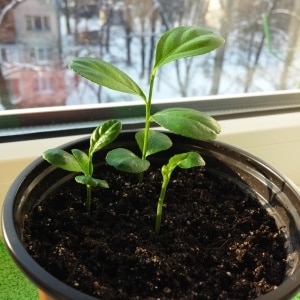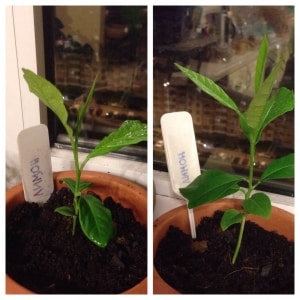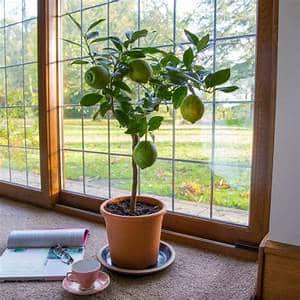How to grow a lemon from a seed at home: planting, care, nuances and mistakes
Lemon is one of the most popular additions to tea. Many people perceive it only as a fruit lying on store shelves, without thinking about how beautiful the tree on which it grows is. The plant is valued not only for its aesthetic appearance, but also for its pleasant aroma; it can even purify the air from harmful microorganisms.
In flower shops, lemons are expensive and rarely found. But you can collect seeds from purchased fruit and grow a beautiful tree yourself. Read on to learn how to do this and what nuances to consider when growing lemons at home.
Is it possible to grow lemon from a seed at home?
It is possible to grow a lemon from a seed. This process is longer than propagation by cuttings, but allows you to get a strong and hardy tree.
Indoor lemon is a perennial, evergreen, low-growing tree.. It has powerful, thorny greenish-brown branches. Young shoots have a violet-purple hue.

The leaves of the plant are leathery, dense, green, oval-shaped with teeth. They contain many glands with essential oils. Thanks to this, the tree emits a citrus aroma and has a positive effect on the air quality in the apartment.
Lemon flowers are pink or purple on the outside and white or light yellow on the inside. The buds develop within 4-5 weeks.The opened inflorescences do not fall until 9 weeks, all this time exuding a pleasant, subtle aroma.
Lemon is not only an ornamental tree, but also a fruit tree. Ungrafted indoor plants also bear fruit. However, grafting accelerates the growth of the plant and allows you to get the harvest much earlier.
The tree begins to bloom in 2-3 years, and a full harvest can be obtained only after 4-7 years.
From the moment the ovary appears until the fruit ripens, about 9 months pass. Indoor lemons grow smaller than on trees growing in a greenhouse or open ground.
Note! Lemon is propagated not only by seeds, but also by cuttings.
Planting lemon seeds at home
Growing lemons at home is easy. It is important to choose and plant the material correctly. This determines whether the seeds will germinate and whether the plants will take root after transplantation.
Selection and preparation of planting material

Lemon seeds are bought in specialized stores or collected from ripe fruits. The second option is less expensive and is used more often. However, in this case it will not be possible to accurately determine the type of tree being grown.
The store selects ripe fruits without green spots, damage, rotten areas or signs of disease. It is important that the lemon is as smooth and beautiful as possible.
The thickness of the peel and the color of the fruit do not affect the quality of the seeds. These indicators indicate the type of lemon and allow you to determine what fruits the future tree will have.
The seeds are removed from the fruit. For planting, large, smooth specimens without damage or signs of disease are used.
Lemon seeds are not dried, otherwise they will take a long time to germinate. To reduce the likelihood of infection and speed up germination, they are treated:
- Disinfection. The seeds are soaked for 30 minutes in Fitosporin, a light pink solution of potassium permanganate or hydrogen peroxide.
- Growth stimulation. Lemon is soaked for 12 hours in Epin, Mortar or other growth stimulant. Some use folk remedies, for example, ash solution or aloe juice diluted with water in a 1:1 ratio.
Sometimes the seeds are additionally heated. To do this, they are left near the battery overnight.
Preparing the soil and pot
Before planting and growing lemon, prepare the soil. A universal mixture for seedlings or special soil for citrus fruits is suitable for it. Everything you need is sold in flower and gardening stores.
Many people prepare their own soil mixture. To do this, take 2 parts of humus and garden soil, 1 part of sand or peat and 1 tbsp. ash.
Self-prepared and purchased soil is disinfected in one of the following ways:
- calcined in the oven;
- pour over with a dark pink solution of potassium permanganate;
- pour over a solution of copper sulfate (1 tbsp per 5 liters of boiling water).
When growing lemons in a pot, be sure to use drainage - crushed ceramics, coarse sand, expanded clay, small crushed stone, and special glass pebbles. Drainage is disinfected in the same way as soil.
Lemon seeds are planted in a common box, pots, cut bottles, etc. Since the planting material will have to be picked, it is more convenient to use a common container.
The containers are also disinfected: doused with boiling water or soaked for 30 minutes in a dark pink solution of potassium permanganate.
Important! If you use homemade containers, holes are made in the bottom.
Step-by-step planting instructions
Procedure:
- A 1 cm thick layer of drainage is poured onto the bottom of the container.The rest of the volume is filled with soil so that 2-4 cm is left free to the edge of the container.
- The soil is moistened with warm water from a spray bottle.
- The seeds are planted in the ground to a depth of 2 cm. A distance of at least 5 cm is left between the seeds.
- The soil is compacted and moistened again with a spray bottle.
- The boxes are covered with film and put in a warm place.
Instead of a box and film, cut bottles covered with the top are often used.
This is interesting:
Limonka potato variety: description, characteristics and reviews.
Beneficial properties of a medicinal mixture based on honey, lemon and celery root.
Let's make delicious and healthy carrot and lemon jam for the winter.
Growing a lemon tree at home
When grown at home, lemons are often left without leaves, do not bloom, do not produce a harvest, and quickly die. This is due to improper care. Growing citrus fruits is significantly different from cultivating ordinary houseplants.
In order for a tree to please for decades and produce a rich harvest, it is important to provide it with regular care.
Care before the first pick
The seeds germinate 2-4 weeks after planting. Plants are replanted after the appearance of 3-4 true leaves. Before this happens, it is important to provide the seedlings with proper care.
Step-by-step instructions for caring for lemons before transplanting:
- Lemon is a tropical plant. Its fragile sprouts require high humidity. To ensure the necessary conditions, the seedlings are kept under film until 2 true leaves appear.

- The seedlings are watered with a spray bottle 2-3 times a week. The soil must be constantly moist. For irrigation, use settled water at room temperature.
- It is important to provide the plant with at least 80% humidity.
- Lemons are ventilated daily by opening the film for 30-60 minutes.
- Boxes of lemons are not placed on the windowsill. Direct sunlight is harmful to immature plants.
- Weeds should not be allowed to grow near lemon sprouts.
- The temperature in the room where lemon is grown should not be higher than +22°C.
- At the stage of growing seedlings, lemons are not fed.
Selection of seedlings and transplantation
When the seedlings have 3-4 true leaves, they begin to transplant them into individual containers. The strongest and healthiest seedlings are selected based on the following characteristics:
- Crown density. Take plants with a small distance between the buds.
- Needles. Seedlings with a minimum number of needles are selected.
- Leaves. The more leaves the better. They should be bright green and not fall off if you shake the plant.
All shoots with dull, weak leaves and undeveloped stems are thrown away.
Shoots suitable for transplantation are removed from the soil with a fork. It is important not to damage the roots and leave a lump of earth on them.
Clay pots with a diameter of at least 10 cm and a height of at least 20 cm are best suited for replanting. The pots are disinfected. Then a layer of drainage 1 cm thick is poured onto the bottom. The rest of the volume is filled with soil, which is watered with warm water. Lemons are planted in individual pots without deepening the root collar. Until the plants take root, they are protected from sunlight.
Further care
When growing lemon at home, it is important to pay enough attention to caring for it. After transplanting the seedlings into individual pots, the following agricultural technology is used.
Lighting
In summer and spring, natural light is enough for lemon, provided that the pot is on the balcony or windowsill.The pot is turned in relation to the window a few centimeters weekly.
As the days get shorter, there is not enough natural light. In winter and late autumn, turn on a phytolamp located at a distance of 20 cm from the plant for 5 hours.
Spraying and watering
To create optimal humidity, the lemon is sprayed with settled water at room temperature. In summer this is done 3 times a week. In winter, if the plant is near the battery, daily.
From late spring to early autumn, water the lemon every other day. During the cold period, it is enough to moisten the soil twice a week. For irrigation, use settled water at room temperature.
Once a week, wipe off dust from all leaves of the plant with a damp cloth.
Loosening the soil
The next day, after each watering, the soil is loosened. To do this, use a special rake for house plants or a regular fork.
Feeding
For the first 2 years, plants are fed once every month and a half. Adult lemons are fed once every 2-3 weeks in spring, summer and autumn, and once every 1.5 months in winter.
For feeding, use an infusion of birch leaves and ash, rotted manure diluted 1:10 with water, superphosphate and special complex fertilizers for citrus fruits.
Transplants
Up to 3 years, lemons are transplanted into a new pot once a year. Older lemons are replanted once every 2-3 years. Each time they take a pot 5-7 cm larger than the previous one.
Temperature
Comfortable temperature for a citrus tree is +15…+18°C. It is especially important to observe the indicators during flowering, because at temperatures above +22°C the plant sheds its inflorescences. In winter, lemon is comfortable at a temperature of +12…+14°C.
Formation
Special attention is paid to crown formation.Otherwise there will be no harvest.
Use the following scheme:
- When the plant reaches a height of 20-30 cm, pinch out the main (zero) branch.
- The next shoot is pinched at a height of 15-18 cm from the place of the previous pinching. There should be at least 4 developed buds left on it.
- Shoots growing from the buds are pinched at a level of 20-30 cm and cut after ripening at a level of 5 cm from the previous pinching site.
- Each subsequent shoot should be 5 cm shorter than the previous one.
Formation is completed on branches of the 4th order. Fruits are formed on shoots of the 3rd and 4th order.
Difficulties and nuances
When caring for lemons, you need to know a few nuances and be prepared for problems that may arise:
- If a lemon blooms in the first year, all the inflorescences are cut off, otherwise it will spend all its energy on flowering and die.
- In the second and third years, 2-3 buds are left on the tree, the rest are cut off. From the fourth year of life, the flowers on the lemon are not touched.
- To increase productivity, in the second year of life the trunk is tied at the base with copper wire. Gradually, the plant bark will close the ringing.
- If the leaves of a plant turn yellow, then the reason is a lack of moisture or nutrients, stagnation of fluid, or dry air.
- In winter they watch how the lemon grows. If the size does not increase, it is allowed to rest without feeding during the cold period.
Diseases and pests of indoor lemon
Indoor plants are susceptible to fewer pests than those growing outdoors. At home, lemon trees are affected by scale insects, aphids, and spider mites.
They are dealt with using the following methods:
- Mechanical way of fighting. A soft toothbrush or cotton swab is moistened in a solution of laundry soap. The tool is used to remove pests from leaves and branches.After a day, the soap solution is washed off with a cotton swab soaked in clean water.
- Traditional methods. Lemons are sprayed with an infusion of orange peels, a decoction of herbs, and an infusion of tobacco. Laundry soap is added to each product.
- Chemicals and biological products. Purchased products are used if home and mechanical remedies do not help. An example of a biological product is Fitoverm.
At home, lemon suffers from fungus or gommosis. In the first case, the leaves become covered with a gray coating, in the second, gum forms on the branches. Without timely treatment, the plant dies.
Fight diseases using the following methods:
- Bark with signs of damage is cleaned. The problem area is treated with copper sulfate.
- Sore spots are lubricated with RanNet plant medicine or garden varnish.
- Leaves affected by fungus are cleaned with a damp piece of cloth.
After treatment, the plants are fed. This will help them recover and not get sick again.
Conclusion
It is possible to grow a lemon from a seed in a pot at home. If you choose the right planting material and follow the standards of care, in 4-7 years you will have not just a beautiful ornamental plant, but a tree that produces a rich harvest every year.